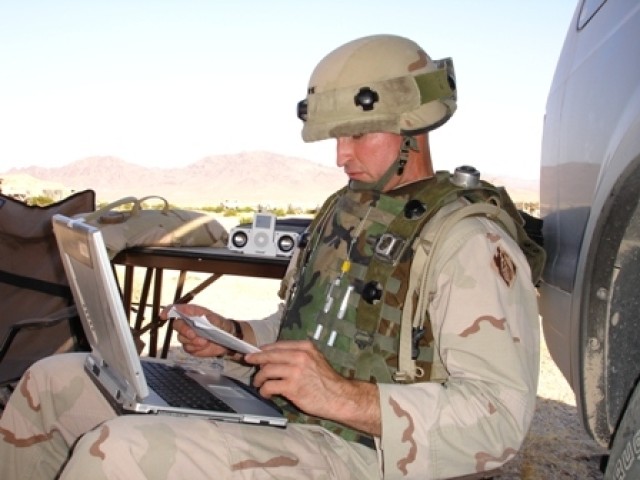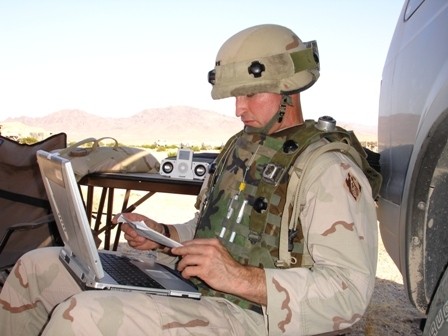To hit the ground running - that is the goal of the field force engineering equipment management team supporting contingency operations. Time spent troubleshooting and setting up equipment is time taken away from the mission that called you there in the first place.
Since the mid 1990s, the Corps of Engineers' Forward Engineer Support Teams (FESTs) have deployed into theater as advance (FEST-A) and main (FEST-M) teams for Army operations as part of the Field Force Engineering (FFE) doctrine. In tow are their tools of the trade: a myriad of laptop computers, cameras, global positioning systems, satellite phones and local area network systems that allow teams to complete complex engineering, design and contracting duties in somewhat austere environments.
"It's a proven concept," said Tom Jankiewicz, an operations officer with Plans and Operations.
"By doctrine there are currently eight FFE FESTs in addition to contingency real estate (CREST), logistical support (LST) and environmental support teams (EnvST)," said Jankiewicz. "If there is a military contingency, the Corps will send in a FEST-A team that deploys with the warfighter and provides engineer support."
As the Corps' support to the global war on terrorism enters its fifth year, the inventory of ad hoc equipment sets has grown and is spreading across the Corps in district and division offices.
"Over time, these systems have aged, become obsolete, or become scattered throughout USACE," said Jankiewicz. "With the continuing demands for forward elements for current operations in Iraq, Afghanistan and elsewhere, commanders realized they needed to get their FFE equipment inventory under control to ensure operational readiness."
USACE needed centralized oversight and management of the assets and the mission was assigned to TAC.
<strong>Accountability</strong>
The first part of the process started last March - the identification and accounting of all FFE equipment already in the Corps' inventory.
The team from TAC will focus on the standardization, update and eventually sustaining the maintenance and management of the equipment and systems located throughout the Corps.
"We're still trying to figure out what all is out there," said Jankiewicz. "We have about a year to complete the inventory." Some districts have chosen to store their FFE equipment centrally at TAC while others will maintain their equipment at their home stations. Each district and division gets a vote on where their equipment resides.
"Some districts are sending their equipment to us but we want to be able to maintain a regional response readiness," he said. "Not everything will be housed here; teams in the districts also need this equipment to train on (between contingencies)."
Keith Felde, FFE equipment manager, and other members of TAC are in the process of making several trips to districts and divisions to physically inspect all FFE equipment throughout the Corps, said Jankiewicz. "TAC will take responsibility for the equipment. We'll re-barcode what is out there and hand receipt it back to the districts. This will allow us to see the entire FFE equipment inventory on one property book. It will also allow headquarters to reallocate the equipment as needed. We need to get a good accountability."
A lot of the equipment that initially went into Iraq and Afghanistan was older FEST equipment. Some of it has been lost, damaged or become obsolete, Jankiewicz said.
"As part of the inventory, the TAC operations team will evaluate what can be salvaged, what needs to be replaced, and also ensure that fully operational kits are in place," he said.
<strong>Standardization and Update</strong>
"Conceptually, once completed, these teams will have a robust capability. The FEST-M is often referred to as a mini-district with the ability to pick up and move forward into the area of operations," said Jankiewicz.
"When FFE equipment was initially purchased, it was not standardized," he continued. "For instance, some kits had Panasonic computers and others had Dell. There were different printers and other equipment that were sometimes incompatible with existing equipment, especially when teams from different districts merged their equipment. You'd have personnel trained on one piece of equipment, and then they fell in on someone else's equipment. What they trained on and what they used was not the same thing - we're going to try to prevent that from happening in the future."
<strong>Maintenance</strong>
The third step in the process will be a maintenance and management system to ensure the equipment inventory stays current and usable.
"Once we get our arms wrapped around what we have, then we want to ensure it's maintained properly," said Jankiewicz.
The TAC team has already identified otherwise usable equipment at several districts and divisions - some brand new, which would not be ready if the call to deploy came.
"Some laptops are still brand new, but they haven't been updated with current software ... In other cases batteries are dead," said Jankiewicz. "We know there are districts out there that have good equipment, but it's not ready to go. That's something we're trying to organize."
To stay on top of the equipment inventory and management program, the TAC team has also developed a Web site to provide up-to-date information to commanders and teams. "Keith Felde developed the site to manage the FFE equipment management mission," said Jankiewicz. "Anyone involved with the equipment management will be able to go online and view the status of their equipment. It will include the maintenance schedule, standard operating procedures, updates and other information. The ultimate goal is for that to become the single equipment management tool. If a commander wants to investigate the status of the equipment in his or her area, then it's simply a matter of logging on to the Web site. Green, amber and red status will quickly alert them if there is a problem."
With the potential of the FFE program expanding to 27 FESTs, the timing for this effort couldn't be better.
This is yet another area where TAC is contributing to the Corps of Engineers' expeditionary mindset capabilities - to be able to deploy around the globe, often with little notice, to support wartime or disaster recovery operations.


Social Sharing